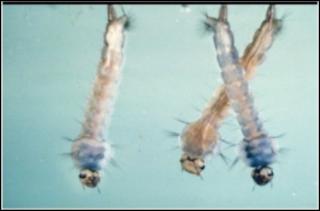Larvae

The larvae of all mosquitoes live in still, non-flowing water. Some species live in permanent swamps and marshes, some in water contained in tree holes or other containers (tires, catch basins, etc.). Other species develop in areas that are only wet for a period of time (such as vernal pools). Mosquitoes have adapted to live in many types of water, fresh water, salt water, and even water polluted with garbage, and organic waste from humans and animals. Polluted water such as this will produce an amazing number of larvae compared to a similar amount of clean water. A few species such as Psorophora ciliata are predaceous, and will feed on aquatic insects, including other mosquito larvae.
The three body segments, head, thorax and abdomen are distinct. No other Diptera larvae share this characteristic. Mosquito larvae are dependent on still water to be able to use the surface tension on the top to attach their siphon tube and breath air. Because of this limitation, larvae are not found in moving streams and river, open lakes and seas. One notable exception to this rule is the larvae of Coquillettidia perturbans, which is able to attach itself to the roots and tubers of under water plants (typically cattails). They breathe air through the plants roots itself. Floodplains alongside many rivers provide an ideal site for breeding once the floodwaters subside.
The larvae go through four different stages, called instars. At the end of each instar the larvae molts, or sheds it's skin. The fourth instar is the mature larvae, and the next stage is the pupae. This process requires a minimum of 4-10 days (in the summer) to as long as several months (in the spring). Most larvae have similar characteristic positions and movements, with the exception of the Anophelene larvae. The rate of development depends mainly on the availability of food and the temperature of the water. In the spring, larvae of Culex pipiensmay require 15 days to mature, but in the summer may only need 5 days. Larvae that overwinter, such as Cq. perturbans and C. melanura, may need several months to complete their life cycle.

